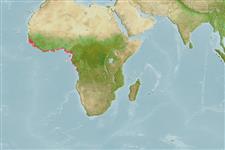Actinopterygii (ray-finned fishes) >
Clupeiformes (Herrings) >
Clupeidae (Herrings, shads, sardines, menhadens) > Dorosomatinae
Etymology: Ethmalosa: Greek, ethmos, -ou = sieve, also the ethmoides bone + Latin, alausa = a fish cited by Ausonius and Latin, halec = pickle, dealing with the Greek word hals = salt; it is also the old Saxon name for shad = "alli" ; 1591 (Ref. 45335).
Environment / Climate / Range
Ecology
Marine; freshwater; brackish; pelagic-neritic; catadromous (Ref. 51243); depth range 0 - ? m (Ref. 54436), usually 0 - 50 m (Ref. 54436). Tropical, preferred 27°C (Ref. 107945); 25°N - 8°S, 17°W - 14°E (Ref. 54436)
Atlantic Ocean: Eastern central Atlantic Ocean from Dakhla in Western Sahara to Lobito Bay in Angola (Ref. 188, 81269, 81631). Reports from Cape Verde Islands are based on an erroneous type locality for Clupea fimbriata by Bowdich (1825) which was followed by later authors (Ref. 188).
Length at first maturity / Size / Weight / Age
Maturity: Lm 17.0 range ? - 18.5 cm
Max length : 45.0 cm TL male/unsexed; (Ref. 5377); common length : 25.0 cm TL male/unsexed; (Ref. 26999)
Dorsal
spines
(total): 0;
Dorsal
soft rays
(total): 16-19;
Anal
spines: 0;
Anal
soft rays: 19 - 23. Diagnosis: Ethmalosa fimbriata is distinguished from other clupeids by the presence of a median notch on the upper jaw, into which tip of lower jaw fits (Ref. 188, 81269). A faint dark spot behind gill cover, sometimes followed by others; dorsal fin tip black; caudal fin deep chrome yellow; golden tints on body (Ref. 188). Ethmalosa fimbriata resembles Sardinella aurita, Sardinella rouxi and especially Sardinella maderensis, but these are more slender, have a rounded upper jaw which is not notched and the upper gillrakers are not bent upward like an elbow (Ref. 188).
Ethmalosa fimbriata is found in coastal and estuarine regions, and sometimes also in lower courses of coastal rivers, even more than 300 km up rivers (Ref. 188, 81269, 81631). It feeds by filtering phytoplankton, chiefly diatoms (Ref. 188). It breeds throughout the year in waters of salinities 3.5-38 ppt, but with peaks in at least some areas; spawns in the sea, in estuaries and in rivers (Ref. 188).
Breeds all year in waters of salinities 3.5 to 38 ppt, but with peaks in at least some areas, becoming progressively later to south. Spawns in the sea, in estuaries and in rivers.
Whitehead, P.J.P., 1985. FAO Species Catalogue. Vol. 7. Clupeoid fishes of the world (suborder Clupeioidei). An annotated and illustrated catalogue of the herrings, sardines, pilchards, sprats, shads, anchovies and wolf-herrings. FAO Fish. Synop. 125(7/1):1-303. Rome: FAO. (Ref. 188)
IUCN Red List Status (Ref. 115185)
CITES (Ref. 94142)
Not Evaluated
Threat to humans
Harmless
Human uses
Fisheries: highly commercial; aquaculture: experimental
More information
ReferencesAquacultureAquaculture profileStrainsGeneticsAllele frequenciesHeritabilityDiseasesProcessingMass conversion
Tools
Special reports
Download XML
Internet sources
